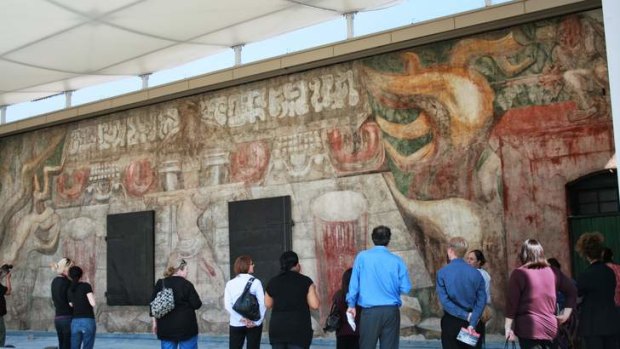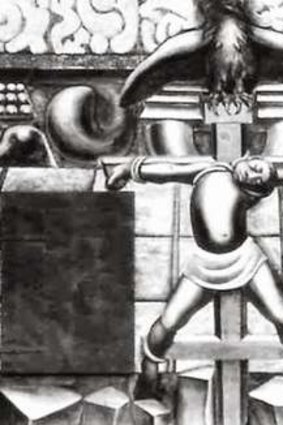By Tim Richards

Visitors consider the enduring relevancy of America Tropical.
The woman with the pram seems unimpressed. ''You can't see much, can you?'' she says, squinting against the brightness of the Los Angeles sunshine while trying to take in the details of a faded mural two rooftops away from our position.
The details of David Siqueiros' America Tropical (1932) are hard to make out beneath its specially constructed canopy, which protects it from further deterioration. Faded by the passage of years, its sketchy outlines on a bone-coloured wall seem unimpressive compared with the attention-grabbing Mission Revival-style post office building off to the right.
So the woman shrugs and departs, leaving myself on the platform of the America Tropical Interpretive Centre with its attendant. She tells me a lot of visitors react this way to the latest attraction of El Pueblo, LA's oldest district and a repository of its Spanish and Mexican past.

America Tropical.
However, to truly ''see'' America Tropical, I have learnt, you need to view it in context - not as an obscure artwork from the city's past but as a political flashpoint of 1930s LA.
The City of Angels was anything but serene in those days. Arriving after a period of house arrest in Mexico for socialist activism, Siqueiros had found a city in the grip of the Great Depression, seething with unrest at unemployment and homelessness as it prepared to host the 1932 Olympic Games. Offered a commission to paint a wall facing a rooftop bar with an idyllic Mexican-themed scene, the renowned muralist was not about to pass up the opportunity to express his revolutionary ideals.
Siqueiros managed to conceal the most controversial elements of his mural until the big night. Then, on October 9, 1932, in front of a crowd of celebrities, artists and reporters, America Tropical was unveiled. As expected, it featured the ruins of an Aztec temple, set prominently against a lush jungle background. But in the centre of the composition was the crucified body of an indigenous Mexican, head lolling lifelessly to one side. Above the body perched an American eagle, its wings spread triumphantly. To complete the tableau, Siqueiros had added two Latin American revolutionaries crouching with rifles.
His startling vision inevitably met with reaction. In March 1934, the portion of the mural visible from Olvera Street below was whitewashed by persons unknown, and the rest of the work followed quickly. By the end of 1938 it had been concealed completely.
Decades later, however, ghostly outlines of the mural began to appear through the fading whitewash, and art critics campaigned for its preservation. In 1988, the Getty Conservation Institute partnered with the City of Los Angeles to conserve the work, and make it accessible to public view.
On the mural's 80th anniversary last year, the America Tropical Interpretive Centre was opened. At street level, the centre provides context via exhibits explaining the explosive politics of '30s Los Angeles. Above is the observation platform, its signage displaying a detailed sketch of the mural to aid viewers.
I am fascinated by the mural's backstory, and intrigued by how people regard it now. After all, the issues Siqueiros was railing against - militarism, racism, the excesses of capitalism - remain hot-button topics.
John Kopczynski, of the El Pueblo de Los Angeles Historical Monument Authority, sees the mural's historic context as its key asset. He says: ''This is here to ask, 'Do you know what was happening in 1930?' It's a new discovery for a lot of younger students that come here, who have no idea who Siqueiros was, let alone the political ideology of the time.
''There's no question it's still provocative. Is it going to cause someone to come up here and gasp and have to sit down? I don't know, but of course it's controversial. It makes you think about American expansionism, colonialism, and how the indigenous were treated then, now and in the future; so it brings up a lot of questions.''
I suggest to Kopczynski there is a fascinating clash of visions of the past here in El Pueblo. Outside the interpretive centre is a colourful Mexican marketplace dreamt up by wealthy socialite Christine Sterling in the '20s, as a way of saving historic El Pueblo from redevelopment. Decked out with sombreros, wrestling masks and woollen shawls, it is a world away from the confrontational mural on the rooftop above.
''You're right,'' he says. ''Down below it's Mexican handicrafts and taquitos, and then you come up here.
''I think what it does more than anything else is give a historical context to not only this, the birthplace of Los Angeles, but to the city of Los Angeles itself. In the 1930s, this was a cauldron of bubbling discontent and political ideologies, and it frames the history of this city.''
For my part, as a keen student of history, I hope its viewers in the 21st century see America Tropical as more than a museum piece. It may seem like a ghost from the past, but the issues that inspired its creation are very much alive.
■ Tim Richards travelled courtesy of Fiji Airways and the Los Angeles Tourism & Convention Board. americatropical.org
Sign up for the Traveller newsletter
The latest travel news, tips and inspiration delivered to your inbox. Sign up now.